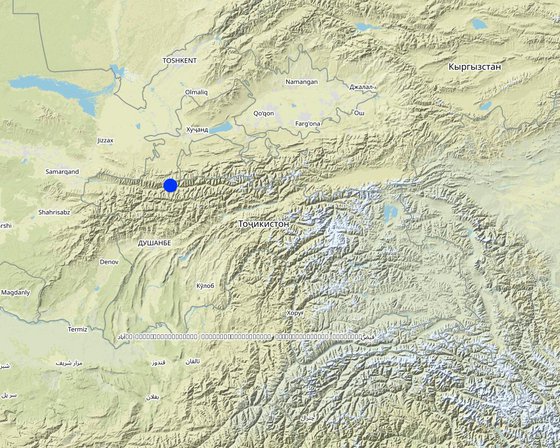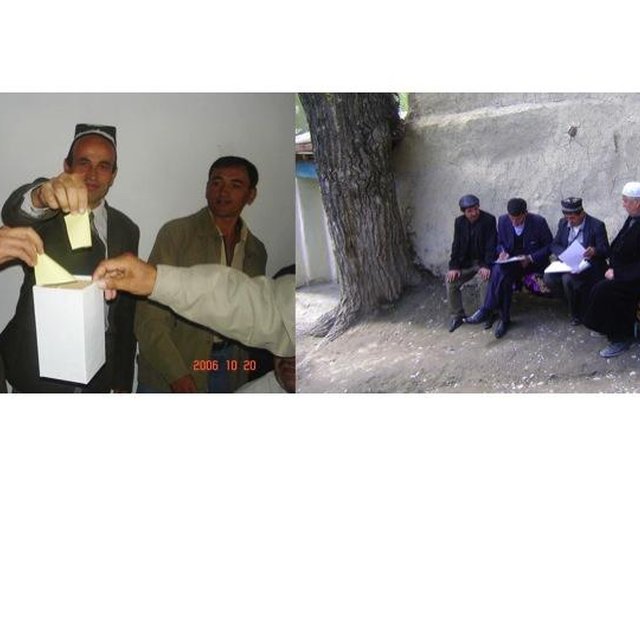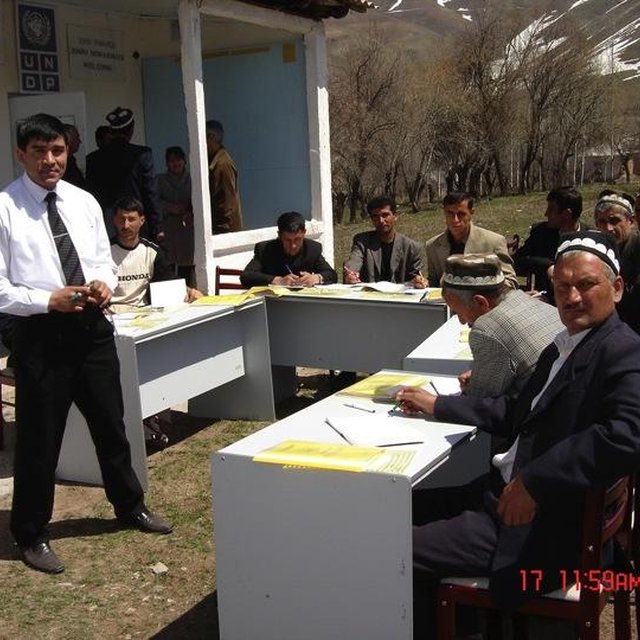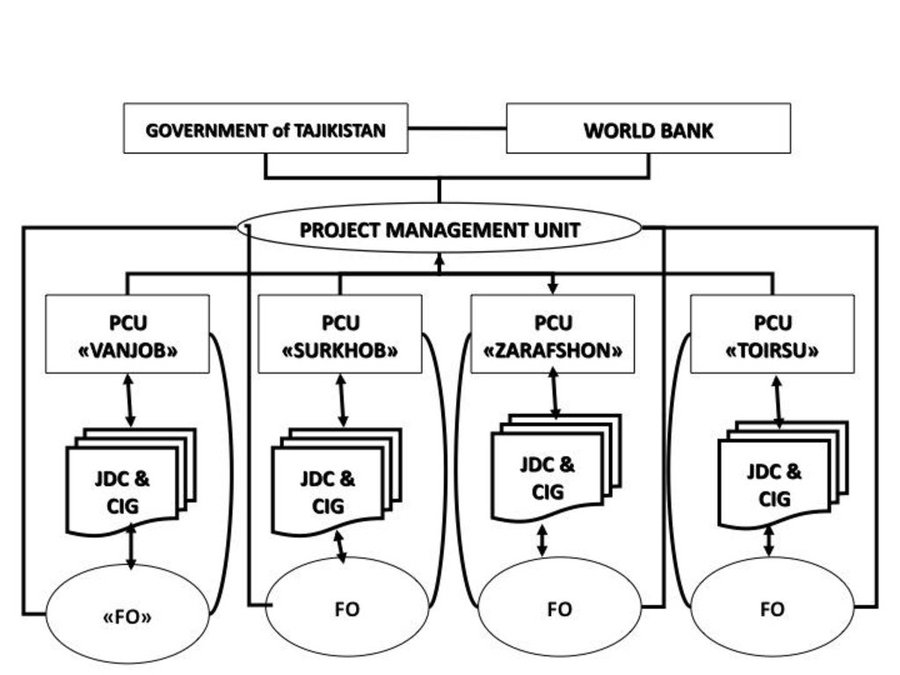



Aims / objectives: The Tajikistan - Community Agriculture & Watershed Management Project (CAWMP), aimed to use a sub-district level organization to provide more efficient, transparent and accountable services to farmers for the project duration. CAWMP financed small grants to farmer groups for agricultural production in environmentally sustainable ways in Tajikistan’s uplands. The sub-district level support for this initial six year period, together with support from other project partners, helped (a) enable project implementation, and (b) build farmer capacity to sustain the investments after the end of six-year project, even in the absence of continued outside support.
Methods: In four project sites 39 Jamoat (“sub-district”) Development Committees (JDCs) operated as NGOs with elected officers and helped organize 43,000 households into groups to implement 4,000 rural production investments that included varied SLM technologies in 402 villages. JDCs managed $7.4 million in small grants. Use of the JDC built upon existing initiatives to strengthen local governance. The JDCs collaborated and received support from a government-appointed Project Management Unit (PMU), field-based Project Coordination Units (PCUs), and four contracted Facilitating Organizations (FOs). These partners helped train JDCs in financial, organizational, and technical aspects (e.g. fund flow, participatory planning, SLM technologies), and assisted villages to form new JDCs where none existed.
Stages of implementation: JDCs, with FOs and PCU specialists, undertook activities including: 1) preparation of participatory village-based Community Action Plans (CAPs) that included proposed rural production investments and formation of Common Interest Groups (CIGs) of households [See TAJ046}; 2) participation in sub-district and project-site/watershed level screening and approval of rural production proposals from CIGs to ensure economic, environmental and social feasibility [See TAJ045]; 3) management and disbursement of grant funds from the PMU to CIGs [See TAJ 044]; 4) overseeing formal investment agreements with participating CIGs; 5) monitoring, evaluation and reporting; and 6) liaison with other villages and relevant government agencies to facilitate permissions, resource use agreements, issuance of land use rights, etc.
Role of stakeholders: JDCs comprised elected village representatives and the government’s sub-district officials. Generally, JDC members have relatively higher levels of education and relevant knowledge and experience than the local population. A JDC chairperson and secretary were elected and a qualified accountant/bookkeeper appointed. JDCs met monthly and established committees, (e.g., gender, environment, financial management and social). CAWMP paid an honorarium for the accountant and incremental travel costs for all JDCs. For newly established JDCs, CAWMP also provided funds for office facilities, plus an honorarium for the chairperson, and an additional honorarium for another officer if one was female.

Lugar: 7 districts and 39 sub-districts, Sughd, Khatlon, RSS, GBAO, Tayikistán
Dato de inicio: 2005
Año de conclusión: 2012
Tipo de Enfoque

| ¿Qué partes interesadas/ entidades implementadoras estuvieron involucradas en el Enfoque? | Especifique las partes interesadas | Describa los roles de las partes interesadas |
| usuarios locales de tierras/ comunidades locales | JDCs registered as non-profit, non-government organisations Most JDCs had women members, but overall levels of female participation were less than 25%. Social and cultural circumstances, especially in the more remote upland areas, place restrictions on the extent to which women can actively participate in organisations such as JDCs. Among the four project sites, there were also differences in the number of women represented in JDCs There was some representation in JDCs of poor, vulnerable households, as well as single female-headed households | |
| ONG | International NGOs: Welthungerhilfe, Aga Khan Foundation/Mountain Societies Development Support Programme | |
| gobierno nacional (planificadores, autoridades) | Project Management Unit, Project Coordination Units | |
| organización internacional | UNDP-Tajikistan, FAO-Tajikistan |
Implementation Arrangements for Community Agriculture and Watershed Management Project

Las decisiones fueron tomadas por
La toma de decisiones se basa en
Organisational Management, Book-keeping, Participatory rural appraisal, Participatory environmental planning and analysis, a range of SLM technologies, monitoring and evaluation, gender awareness.
While the JDCs did not directly carry out formal research, they participated as respondents in the project evaluations that were carried out by the NGOs, and the PMU. These evaluations included findings from a variety of stakeholder perspectives about the JDC involvement.
Providing sub-district-level support was critical for implementing almost 4000 rural production investments that integrated SLM practices into the management of over 96,000ha.
JDCs helped target vulnerable groups during community mobilization and preparation of CAPs. Women comprised 40% of project participants benefiting from rural production investments.
Legal agreement for CAWMP permitted issuance of use rights certificates for sloping lands for horticulture, woodlots and other restricted access uses based on adoption of SLM practices. JDCs assisted project staff in processing certificates for participating households, linking farmers, project staff and government officials. Another project accelerated issuance of arable land certificates.
JDCs existed prior to the project, and CAWMP built upon this arrangement. Institutions similar to JDCs continue to be supported in some regions of the country. However, in accordance with the CAWMP design and the initial risk assessment, land users who have received CAMWP-financed grants are not necessarily dependent on the sustainability of JDC support during the post project period. These farmers should have the capacity, incentives, and the responsibility to sustain their investments.
In accordance with the CAWMP design and the initial risk assessment, land users who have received CAMWP-financed grants are not necessarily dependent on the sustainability of JDC support during the post project period. These farmers should have the capacity, incentives, and the responsibility to sustain their investments on their own during the post-project period.